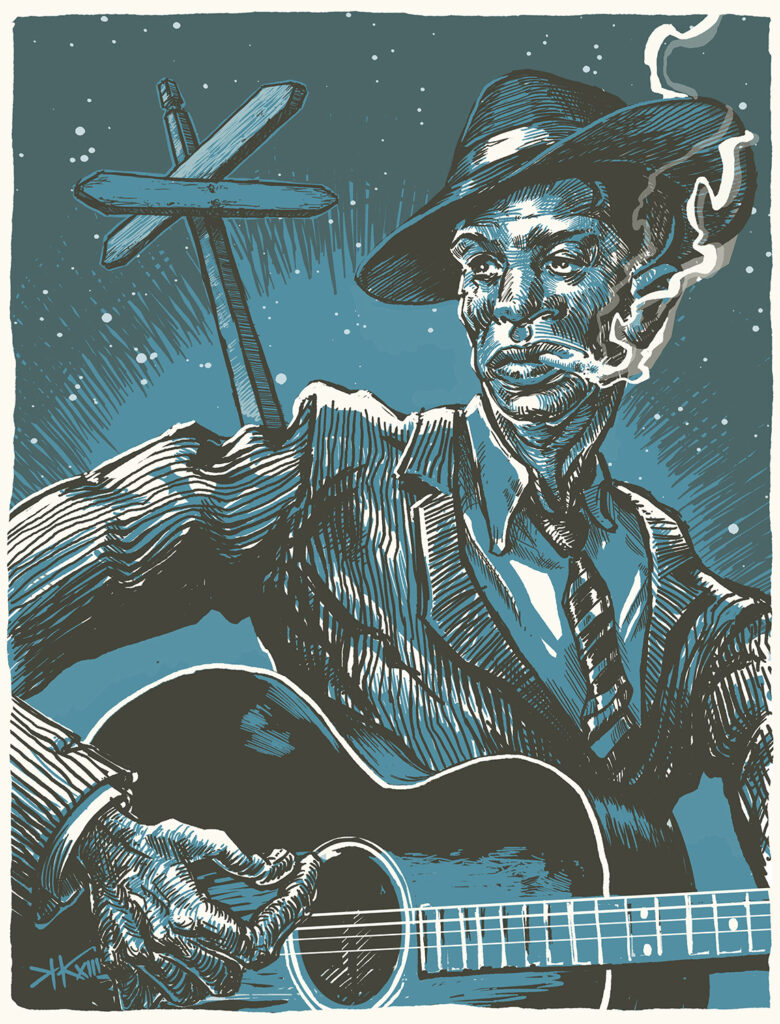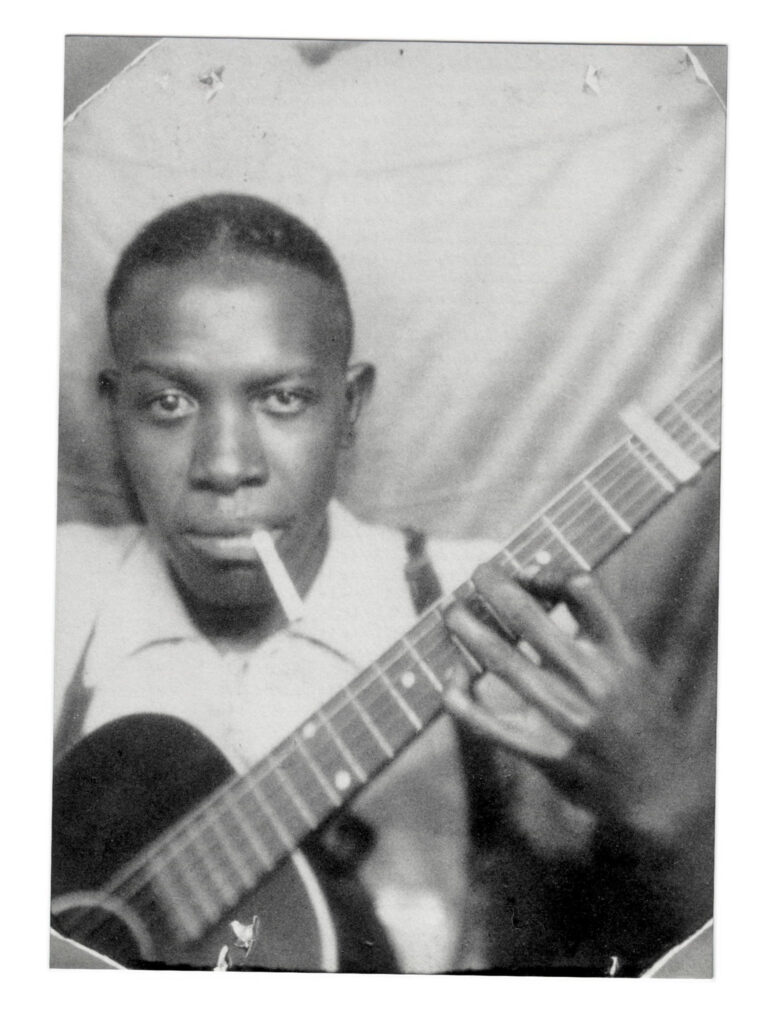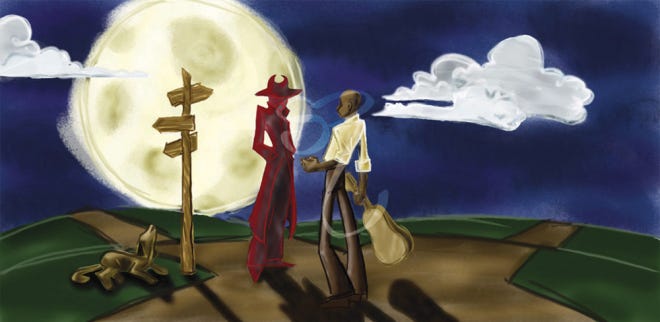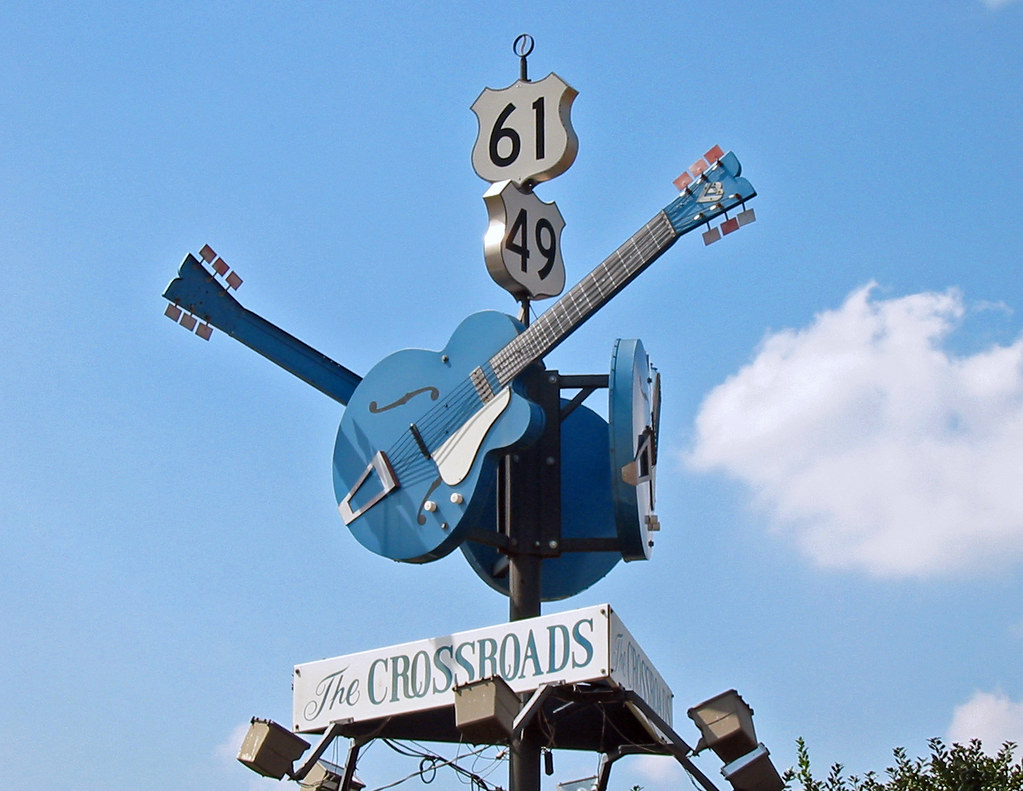

When I was a teenager, I had a friend whose family attended a fundamentalist church tell me that prior to Lucifer’s fall during the “war in heaven,” he was the “angel of music” who was in charge of leading all of heaven’s choirs and writing their compositions. As a result, my friend warned me that if the devil was going to seduce me the easiest way to do this was through music. It was the early 1990’s, and we were in the last half of the “Satanic Panic” and to this well-meaning rightful crusader, my soul was in trouble every time I listened to another Doors tape. But obviously, I didn’t heed his warning and didn’t hand over my music collection for the Baptist bonfire like he hoped I might. If I did, I wouldn’t have the music collection I do now. As a quick aside, I found it hilarious decades later when I saw a family photo on social media featuring the same friend with his kids and spotted his daughter wearing a Sex Pistols t-shirt. Rock n’ roll prevails!

But was there any sort of truth to my well-meaning friend’s message? That’s a debate for you and your personal belief system I suppose. But for centuries it seems that the devil has enjoyed a great song, and stories of musicians making deals with the devil has become a common trope throughout history. In the 1700’s violinists Giuseppe Tartini and Niccolò Paganini were said to have made pacts with the devil in order to achieve greatness at their craft. Much later, during the 1920’s, preachers warned their congregation that the jazz music that was seducing the world’s youth was “the devil’s music,” and of course in the 1950’s Satan was back at it creating sexual deviation and juvenile delinquency via rock n’ roll. And then there was Heavy Metal and Tipper Gore vs. the Music Industry and Marilyn Manson and the stories of music’s connection to sin and depravity keeps marching on. It seems that for those who dare to create music that people enjoy someone, somewhere, is bound to say that the devil had something to do with it.

But the most compelling legend that has come out of the modern era in regard to one musician’s deal with the devil is that belonging to famed American blues man Robert Johnson. Traveling through the Mississippi Delta through the 1930’s, Robert Johnson was a poor unknown musician in life, but in death has become revered as the most important blues musician who ever was. With only 29 known recording by Johnson in existence, he has become an important part of both American music history and the development of rock, folk and country music. But, despite the fame he has achieved, little is known about this mysterious figure, and legend has it that a shady deal made at a Mississippi crossroads at midnight brought him talent, death and fame in that order.

Researchers and music scholars have spent their entire careers trying to unlock the story of Robert Johnson and have never been able to do it. The man is a complete enigma, and due to the American South’s lack of record keeping in regard to their early black population paired with the fact that most of the stories about Johnson were collected nearly thirty years after his death by oral historians talking to grizzled old blues musicians with tall tales to tell, the facts of Johnson’s life is a combination of legend, myth, rumor and contradictions. Thus, I am not even going to try to paint a complete portrait of the man, and I can’t even promise that I’ll get it right. The version I tell will surely contradict the facts another historian has uncovered. But the tale of Johnson’s deal with the devil is a tale worth telling, and the surprising timing and continuing legacy of his death is something too compelling to be ignored.
Born in1911, Robert Johnson spent his early days in Memphis, Tennessee where, despite being a black youth living in the American South, he received an education. But, while his mother hoped that he’d keep his mind on reading, writing and arithmetic, he had discovered a different love – music. Memphis was already a hotbed for musicians, and when young Robert heard the blues, he felt it deep in his soul.

However, when he was nine Johnson’s mother had left her husband and, marrying an uneducated sharecropper, they relocated to Mississippi. Johnson’s stepfather was a pious man and was suspicious of musicians, and he put the boy on the path of becoming a field worker who would primarily pick cotton. But Johnson couldn’t get that music out of his head, and making his own home-made instruments kept playing despite his stepfather’s disapproval. Finally, at age 17, Robert couldn’t handle picking cotton anymore and he hit the road to become a blues man.
But was he good at what he could do? According to blues musician Son House, Johnson was an accomplished harmonica player, but he was a terrible guitarist. House had met Robert in Robbinsville, Mississippi and said that when he tried to join in with the blues men at different juke joints he’d make such a racket on the guitars that they’d run him off. Not long afterwards, Robert disappeared for a long period of time. It was believed he had gone in search of his birth father who he had never met. But when Johnson showed back up in Robbinsville two years later, the jeering blues men who laughed at him were picking their jaws off the floor. During his time away Robert Johnson perfected all of their individual styles on the guitar and could outplay them all. A transformation had happened in a very short period of time, and suddenly Robert Johnson was the best blues man of them all.
Where had Johnson learned to play guitar so good and so fast? Nobody really knows for sure, but a story began to circulate about the charismatic young musician. It was told that one dark night Robert Johnson met a giant black man at a mysterious crossroad. As the hour struck midnight, the man took Johnson’s guitar and tuned it just right, and then after playing a few songs, returned it to Johnson and told him that now he could play however he desired. However, when the day came that Johnson achieved fame, the man was going to come for his payment – Robert Johnson’s soul.

Where had Johnson learned to play guitar so good and so fast? Nobody really knows for sure, but a story began to circulate about the charismatic young musician. It was told that one dark night Robert Johnson met a giant black man at a mysterious crossroad. As the hour struck midnight, the man took Johnson’s guitar and tuned it just right, and then after playing a few songs, returned it to Johnson and told him that now he could play however he desired. However, when the day came that Johnson achieved fame, the man was going to come for his payment – Robert Johnson’s soul.

Where this meeting between Johnson and the devil was supposed to happen has been disputed. Four cities have tried to lay claim over the fabled meeting – Rosedale, Clarksdale, Beulah and Memphis. Other versions of the legend say that it wasn’t even a crossroad but a cemetery where Johnson met the devil, which is curious as he and his traveling companion Johnny Shines would often be heard practicing together in cemeteries late at night where they’d explain to those who asked that they liked to play there because it was quiet. Obviously, the dead made the best audience.

Where this story originated is uncertain. It seems to be agreed that Robert Johnson did not tell people this story as much as it was a tale that grew organically around him. But a tragedy did fall on Johnson which could have seen the origin of the rumors. When he was 19 Robert met and fell in love with a young woman named Virginia Travis. Virginia’s family didn’t like nor trust Robert and didn’t want to see their daughter hooking up with a musician. But, despite their protests, Virginia married Robert anyway. Johnson would spend months away from Virginia when he and Shines would travel for their wares, and it’s been said that Robert Johnson loved the ladies, and the ladies loved him in return. The chances that Robert was faithful was disputed. But their marriage wouldn’t last long because less than a year after they were wed, while Robert was on the road, Virginia died during childbirth. Some say that it was her angry and grieving family that said that the devil had come to take Virginia and the child as punishment for Johnson’s evil ways. Could this have been the origins of the story? Perhaps.

Through the 1930’s Robert Johnson and Johnny Shines travelled from town to town, playing outside of juke joints during the days for change, and going inside for drinks and tips at night. They primarily stayed in the South, but on occasion made it to the Northern US and, according to one account, made it as far as Windsor, Ontario. Johnson was known to be charismatic, friendly, flirtatious, and promiscuous on stage, but off stage he could be moody and sullen, and he was said to be protective of his privacy and could be considered a loner.

It was in 1936 that fortune changed for Johnson. ARC Records producer Art Satherly had heard of Robert’s talent and sent word to him that he would like to have him do some recordings. It was agreed that Johnson would travel down to San Antonio, Texas where he would meet with producer Don Law and sound engineer Vincent Lieber who would capture Johnson on tape for the first time. On Monday, November 23 Johnson met the men at the Gunter Hotel where they went to two adjoining room. In one room the men from ARC had set up their recording equipment and in the other, Room 414, Robert played alone. But Robert did something that day which the two men from ARC found unusual. When he played, Johnson sat facing a corner where he seemed to just go into his own little world. Not known to be a shy man or prone to stage fright, this seemed to be unusual for Johnson. Later some would say that the reason he did this was so the men recording his music wouldn’t be able to see the devil reflected in his eyes.
Between November 23rd and 27th Law and Lieber recorded 16 of Johnson’s original songs. What should be noted is that it’s been said Johnson rarely played his original compositions during performances, preferring to give the people what they wanted by performing other people’s compositions and the “hits of the day.” But in this selection of songs some curious titles were recorded including “Cross Road Blues,” “Preachin’ Blues (Up Jumped the Devil)” and “If I Had Possession Over Judgement Day.” For decades music scholars would scour the lyrics of these songs to clues of Johnson’s Faustian deal.

The recordings were brought back to New York and released on a series of 78 RPM’s. Although none of them caught on fire, one record, “Terraplane Blues,” sold approximately 10, 000 copies and was considered, at best, to be a regional hit.
The result of “Terraplane Blues” success meant that ARC wanted more recordings, and word was sent back to Johnson to meet Law and Lieber in Dallas this time, where they set up in an old abandoned building. Between June 19th and 20th 1937 another 13 original songs were recorded with even more tell-tale titles such as “Hell Hound on My Trail,” “Me and the Devil Blues,” and “Me and the Queen of Spades.”

It was New York based music critic, producer and talent scout John Hammond who gave Robert Johnson his first critical review in the March 1937 issue of New Masses Magazine. A huge deal in the music industry, Hammond was a man who knew his music, and during the 1930’s he would help launch the careers of Henry James, Count Basie, Billie Holiday and Benny Goodman and then, in his later years, discovered a diverse group of icons including Bob Dylan, Aretha Franklin, Leonard Cohen, George Benson, Stevie Ray Vaughn and Bruce Springsteen. So Hammond had an ear to pick them, and in 1937, with few New Yorkers having even heard of him, Hammond was wild over Robert Johnson. In New Masses, Hammon wrote “The greatest Negro blues singer who has cropped up in recent years … Johnson makes Leadbelly sound like an accomplished poseur.”

Hammond, who had been producing popular concert events in New York, was planning to do a showcase he was to call “From Spiritual to Swing.” His idea was to bring together acts from all over America that would highlight the different styles and traditions of African American performers for a white intellectual audience. The first concert, with headliner Count Basie and his Orchestra, was to be performed at the world famous Carnagie Hall. Although he was in contact with a bunch of various groups, there was one performer Hammond had never met that he wanted more than any other. He wanted to give Robert Johnson his New York debut. He sent out word for Robert Johnson to reach out to him. However, when he finally heard back from his contacts in the Delta, Hammond got news he did not expect. Robert Johnson was dead.

Little information on Robert Johnson’s death is on the certificate, but as always, colorful stories about what happened began to spread. Robert died on August 16, 1938, in the area of Greenwood Mississippi. Some theories are that he died of syphilis, but another more dramatic account surfaced about his demise which has been repeated by multiple people who knew him. According to lore, Johnson, alongside future blues legend Sonny Boy Williamson, were playing a juke joint where Johnson was paying a little too much attention to the owner’s wife. Some stories say that Johnson and the woman had been carrying on for a while, and when the owner discovered the affair and took matters in his own hands. Sending Johnson a bottle of whisky “on the house,” the cuckold barkeep spiked the drink with poison. After devouring multiple poisoned drinks Robert started to feel a horrible pain in his abdomen and his friends had to take him back to his room where he suffered for the next three days before he finally died.

Hammond was horrified at this revelation, but he still wanted to honor the music of the late bluesman at Carnegie Hall. On December 23rd, 1938, Hammond got on stage in front of a packed audience and introduced the music of Robert Johnson, only to explain that he could not be here because he had died five months earlier. However, in a move which would still be unprecedented today, Hammond took two of Johnson’s 78’s out, “Walkin’ Blues” and “Preachin’ Blues (Up Jumped the Devil),” and placing them on a gramophone, played his music for the sophisticated New York audience. For most of the crowd there, this was the first time they had heard the music of Robert Johnson. That night Robert Johnson’s legend was solidified, and he would forever be famous as the greatest American blues artist who ever was.

One could only guess the impact that an appearance at Carnegie Hall would have had on Robert Johnson’s life and career if he been alive to perform at the show. It is curious timing that he would meet his demise just at the same time that John Hammond was organizing what would have been Johnson’s big break. Did the devil keep his promise and come for Robert’s soul as a result of the Carnegie Hall opportunity? It makes one wonder.

But if that’s not strange enough, here is one last thing to contemplate about the life and death of Robert Johnson. At the time of his death Robert Johnson was 27 years old. Sound familiar? That is the same age that musicians including Janis Joplin, Jimi Hendrix, Jim Morrison, Brian Jones, Kurt Cobain, Amy Winehouse and many other musicians who rose to fame fast but met their demise young. Deemed by rock fans and music historians as “The 27 Club,” Robert Johnson was it’s first member. An uncanny amendment to the legacy and legend of Robert Johnson.



